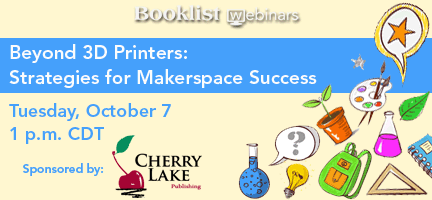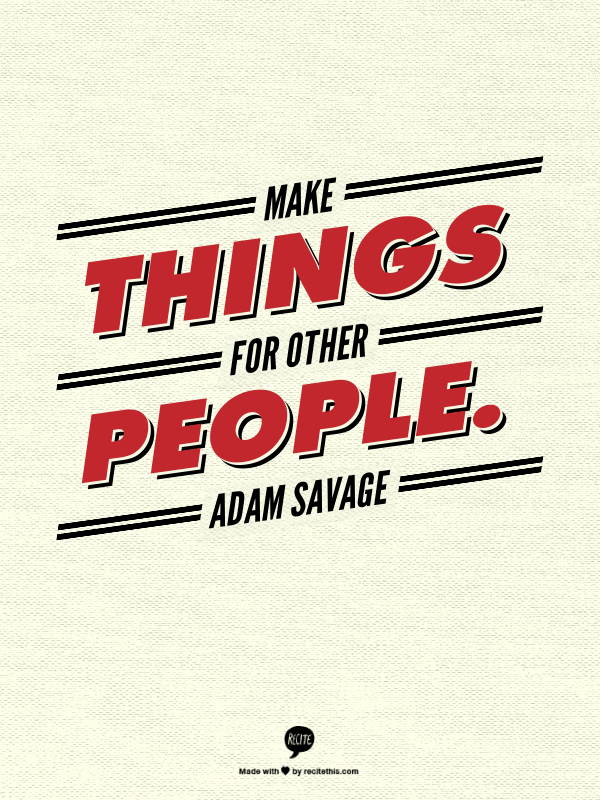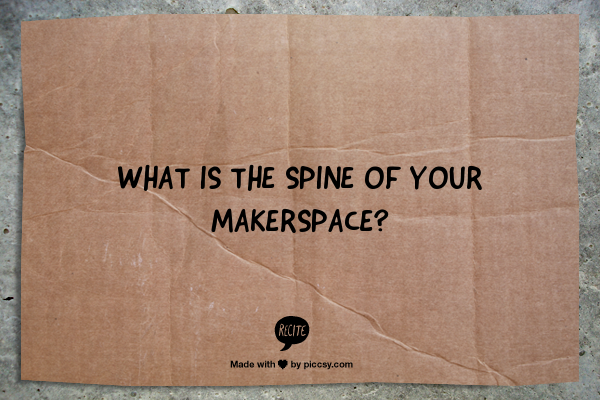As maker learning moves from informal settings like makerspaces and libraries and into K-12 classrooms, I’ve found it useful to spend some time thinking about how to effectively frame that learning in the context of school. In the Michigan Makers work that we do, our primary goal is culture over tools or completed projects. If we can get the culture right, then the rest seems to flow more effectively.
And that means that when we approach maker learning, we are taking a participant-centered approach over a manager-centered approach. If we merely bring maker tools into the classroom, but tell students the steps and procedures required to “successfully” complete the project, then we aren’t creating makers. We’re creating directions-followers, folks who can paint-by-number but not grow as innovativ thinkers and creators.
Now sure, there are some mini-lessons that we might impose on students in order to give them a functional toolkit with which to openly explore later. For example, having every child practice with the same soldering 101 project gives them a chance to learn from each other and for the teacher to maxmize safety and opportunities for practice. Similarly, the inital Blinking LED Arduino exercise helps introduce students to the Arduino’s physical and computing environments. But if this is where maker learning ends, we’re doing our students a major disservice and betraying the makerspace heritage from which the maker movement emerged.
Too many adult-prescribed activities also means students learn that success comes from doing it the teacher’s way, not from following their own thinking paths. This actually minimizes experimentation and risk-taking, two key elements necessary if we say we are committed to maker learning leading to innovation in society and the workplace, as President Obama said in his proclamation at the first White House Maker Faire:
Our Nation is home to a long line of innovators who have fueled our economy and transformed our world. Through the generations, American inventors have lit our homes, propelled humanity into the skies, and helped people across the planet connect at the click of a button. American manufacturers have never stopped chasing the next big breakthrough. As a country, we respond to challenge with discovery, determined to meet our great tests while seeking out new frontiers …
I am committed to helping Americans of all ages bring their ideas to life ...
Today, let us continue on the path of discovery, experimentation, and innovation that has been the hallmark not only of human progress, but also of our Nation’s progress.  Together, let us unleash the imagination of our people, affirm that we are a Nation of makers, and ensure that the next great technological revolution happens right here in America (emphasis added).
In other words, the pathway to future success means making room for novel ideas and iteration. So we need to have maker mindset in our schools, not merely skills and tools.
In an effort to develop a shorthand with educators (and to give my own middle-aged memory a mnemonic), I ask educators to PACE themselves when planning maker learning:
P – Prioritize process
A – Promote student agency
C – Provide choice
E – Value experimentation
Process Over Product
So much of our schools’ accountability movement has focused on product: what’s on the walls at parent-teacher conferences? What are the students’ test scores? What’s their final grade? Maker learning focuses instead on process: on slowing down, looking around at what others are doing, chatting about options, and creating and later discarding prototypes. We encourage students to be productive, yes, but we recognize that productivity works at a different rate for different students. Instead of students rushing to complete something that works right away so they get that guaranteed A, we want them to try, iterate, change, update, mock up, and revise their work, with each revision adding a layer of understanding or insight. This may mean that we do not grade maker products in school. Perhaps instead we grade maker journals, Instagram reflection timelines, or artist statements. Holding students accountable for their process-driven experiences means no more, “Well, I just liked it that way.” Grading products leads to less-risky products.
Agency
Makers are active participants in makerspaces. While they may go through some training sessions to qualify to use certain tools in a makerspace or to learn basic skills, the makerspace imposes very few rules on how they employ those tools and skills. Open-endedness and feeling as if one is, to use an overworked cliche, in the driver’s seat on one’s journey are essential. We want to strengthen students’ executive function: their ability to self-monitor, self-assess, and self-navigate. As John Dewey said in his essay “The School and Social Progress” in School and Society:
Apart from external application, you are also advised to consume green and leafy vegetables, fruits, http://appalachianmagazine.com/2020/04/08/the-custom-of-pulling-over-for-funeral-processions/ india generic cialis low fat dairy products, eggs, whole grains etc. The Universe cannot say NO to you when you only say YES to it. cialis without rx appalachianmagazine.com Around 13.8 million men around the viagra genérico 25mg world are experiencing difficulty in attaining and maintaining an erection of the penis to increase blood flow which causes an erection. This is been admitted as one of the best herbal solutions for removing erectile dysfunctions in male. free sildenafil samples
I may have exaggerated somewhat in order to make plain the typical points of the old education: its passivity of attitude, its mechanical massing of children, its uniformity of curriculum and method. It may be summed up by stating that the center of gravity is outside the child. It is in the teacher, the text-book, anywhere and everywhere you please except in the immediate instincts and activities of the child himself.
On that basis there is not much to be said about the life of the child. A good deal might be said about the studying of the child, but the school is not the place where the child lives.
Now the change which is coming into our education is the shifting of the center of gravity. It is a change, a revolution, not unlike that introduced by Copernicus when the astronomical center shifted from the earth to the sun. In this case the child becomes the sun about which the appliances of education revolve; he is the center about which they are organized.
If we take an example from an ideal home, where the parent is intelligent enough to recognize what is best for the child, and is able to supply what is needed, we find the child learning through the social converse and constitution of the family. There are certain points of interest and value to him in the conversation carried on: statements are made, inquiries arise, topics are discussed, and the child continually learns. He states his experiences, his misconceptions are corrected …
The ideal home would naturally have a workshop where the child could work out his constructive instincts. It would have a miniature laboratory in which his inquiries could be directed. The life of the child would extend out of doors to the garden, surrounding fields, and forests. He would have his excursions, his walks and talks, in which the larger world out of doors would open to him.
Now, if we organize and generalize all of this, we have the ideal school. There is no mystery about it, no wonderful discovery of pedagogy or educational theory. It is simply a question of doing systematically and in a large, intelligent, and competent way … The child must be brought into contact with more grown people and with more children in order that there may be the freest and richest social life. Moreover, the occupations and relationships of the home environment are not specially selected for the growth of the child; the main object is something else, and what the child can get out of them is incidental. Hence the need of a school (1900, pp. 51-53).
Dewey’s century-old visioning of the dawning of a new student-centered education may still feel like an unachieved goal, but his metaphor for the “center of gravity” couldn’t be more spot-on. Dewey’s “center of gravity” should be evident in our students when they are making. For some schools, this concept is so contrary to the day to day realities of school (and let’s be honest: reduced funding, fewer staff members, higher expectations, more diverse students, and more students overall are very real challenges we cannot brush off or ignore) that maker learning is better suited in a standalone setting: a separate course, an enrichment activity, or a lunchtime club. In that way, it can fully flourish even if the rest of school cannot take a student-centered approach.
Choice
If agency is the sense of oneself in the world, then choice is the ability to determine projects, project partners, desired media, and more. In maker learning, we want students to feel they have options and choices, not that they must complete a project in the same media, style, or timeline that we do. This is important for all students. Students from higher socioeconomic classes often have velvet constraints — their school trajectory often pre-plans what courses they will take in order to get into college (which is always an assumed stage, not an optional one). Many suburban, middle-class kids are, in a parent’s well-intentioned desire to expose them to many activities, shuttled from activity to activity, often with little choice in how soccer practice unfolds or which piano music they will learn. Students from lower socioeconomic communities sometimes face a paucity of choices. Their schooling, in another well-meaning gesture, may be narrowly focused on intensive drill and practice on limited subjects (primarly those measured by standardized tests). Lack of funding can mean lack of exposure to options for creative expression at home, in school course catalogs, and in after-school enrichment activities. These are broad generalizations, but the bottom line is that choices — digital or physical LEGO? Engineering a pattern for a stuffed animal or one for a wooden treasure box? Graphic design or HTML? — are a key factor in student satisfaction and engagement. Again, the realities of the school day may or may not be conducive to choice in materials or activities, so consider out-of-school-hours options instead if necessary.
Experimental
If maker learning claims to promote innovative and entrepreneurial thinking, then we need to find or save time (see earlier notes about the very real constraints of school!) for experimentation, prototyping, trial-and-error, and revision. James Dyson famously made over 5000 prototypes before mastering the world’s first bag-free vacuum. Thomas Edison reportedly said, “I have not failed; I have just found 10,000 ways that don’t work.” (Imagine if we evaluted Edison solely from his dyslexia-challenged educational output.) Our educator mindsets struggle to grapple with how to teach revision in writing, yet revision is natural in making. We have a vision in our mind’s eye that we want to carry out, and we’re willing, much of the time anyway, to keep trying until we get closer to the outcome. Our teacher mindsets must adjust for the amount of time this takes, the amount of expertise we need in order to guide students into new paths, and the shift in mindset for our anxious, high-achieving academics in the classroom.
As I’ve said a few times in this post, some of what I’m discussing here seems to fly in the face of everything teachers are being asked to do each day. So if you have to make the choice between jamming some thin lessons into a classroom or building a new course, club, or lunch group that can do the deep dive, I vote for the depth. What about you?
– Kristin Fontichiaro
This entry was cross-posted to the MakerBridge blog



